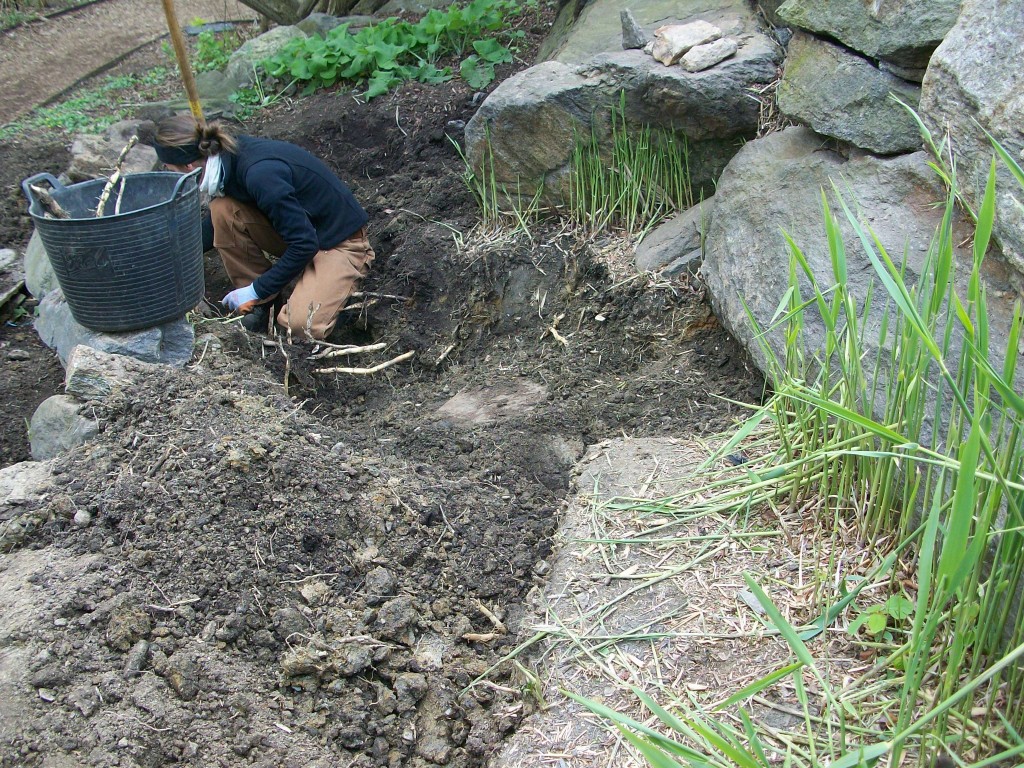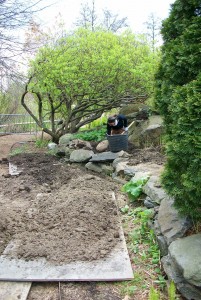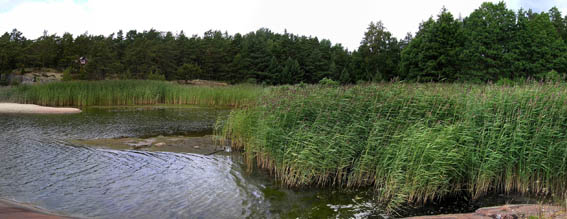Wetland Invaders
Posted in Around the Garden on April 19 2012, by Matt Newman
What the heck is Phragmites? I found myself posing the same question. What could be so diabolical, so absolutely devilish as to demand several days’ sweat and muscle ache shoveling out a muddy pit? Why the misleading singular noun? Sadly (and despite the phonetic similarities), Phragmites has nothing to do with Fraggle Rock. Neither is it related to flaming space junk, or the stone spikes that spur the floors and ceilings of winding underground caverns. Nope–it’s a plant. And, to many, it’s a ruthless swampland invader.

Phragmites australis is a perennial reed preferring wetlands in tropical and temperate regions around the globe. When its hardy underground rhizomes get into the ground, they’re settling in for the long-term. Phragmites grows deep. And no one knows this better than Katie Bronson and the horticulture staff of the NYBG.
 Katie and her team have been knuckling down in the Everett Children’s Adventure Garden wetland, scraping, yanking, and digging out the invading reeds. It’s something of a battlefront as gardening goes. With shovels and gloved hands, the team has been hacking away at the thick, persistent rhizomes of these reeds, which have a penchant for slithering several feet down into the soil and spreading in every which direction–they grow outward at up to 16 feet per year. And while their above-ground stems will happily proliferate en masse, creating reed beds up to 12 feet tall and a square kilometer in size, these plant communities have an even more insidious tendency: they produce gallic and mesoxalic acid, toxins that can be harmful to other neighborhood plants.
Katie and her team have been knuckling down in the Everett Children’s Adventure Garden wetland, scraping, yanking, and digging out the invading reeds. It’s something of a battlefront as gardening goes. With shovels and gloved hands, the team has been hacking away at the thick, persistent rhizomes of these reeds, which have a penchant for slithering several feet down into the soil and spreading in every which direction–they grow outward at up to 16 feet per year. And while their above-ground stems will happily proliferate en masse, creating reed beds up to 12 feet tall and a square kilometer in size, these plant communities have an even more insidious tendency: they produce gallic and mesoxalic acid, toxins that can be harmful to other neighborhood plants.
The problem runs deeper than the roots, however. Up until recently, there was an ongoing argument over the origin of the Phragmites genus. Some suggested that it was a European transplant. Others in turn asserted that it had always been a New World native. In the end, nature seems to have called for compromise: while fossil records show that an apparent subspecies (Phragmites australis subsp. americanus) has been native to North America since before European colonization efforts, the original australis–the “continental” variety–happens to be the vigorous and fast-expanding breed commandeering inland beaches, roadside ditches, and any real estate it can get its rhizomes on. A foreign invader indeed.

Most wild habitat control efforts lean toward a scorched earth policy when it comes to Phragmites–a two- to three-season repeat burn in an attempt to kill off the plant by war of attrition. But we’re not about to start controlled fires at the NYBG. Instead, we do this the old-fashioned way: elbow grease, thick gloves, and a few days’ worth of muscle ache. This reed can be a difficult customer to keep out, with wind-blown seeds and water-swept rhizomes making their way into protected marshes (not to mention Botanical Gardens). On Friday, April 20, employees of the Mitsubishi Corporation (Americas) will be volunteering their time to help with the removal of this invasive pest along the Mitsubishi Wild Wetland Trail, joining in with the efforts of Katie Bronson and her team to combat the enemy on two fronts.
We’re sure that with the combined attack, ECAG and the Wetland Trail will be back to their old form in no time.

